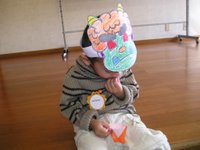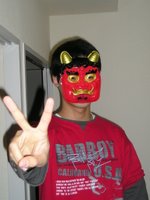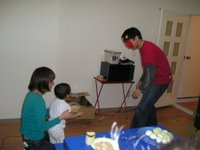Setsubun has been celebrated in many ways, but perhaps the most common custom found throughout Japan is the traditional Mame Maki or the scattering/throwing of beans (mame) to chase away the evil oni (ogres, evil spirits, as depicted in the illustration which heads this article). In some ritual forms, the Toshi Otoko [literally "year man" but referring either to the "man of the house" or to men who are born in the animal sign of the coming year (dog for the year 2006)] will throw mame within the house or at someone perhaps dressed as oni and repeat the saying Oni wa Soto; Fuku wa Uchi (Get out Ogre! Come in Happiness!). After the ritual throwing of the beans, family members may then pick up the number of beans corresponding to their age; eating these brings assurance of good fortune in the coming year.
Eventhough Setsubun is not marked as national holiday, children in Japan are looking forward to for the fun . Some children wear the masks of oni, others madly throwing beans, and all gleefully shouting for evil to hit the road. Prominent temples in Japan may also find monks or celebrities showering large crowds of people with mame to ward off spirits and welcome the renewal of the coming New Year.
The origin story of this setsubun was :
One day an ogre disguised himself and came to the house of an old widow. He possessed a magic mallet, and with it, he fashioned a beautiful kimono. Temptation got the best of the old widow, and she succumbed to its beauty. She plotted to steal it away from the ogre by getting him drunk. Not satisfied with just the kimono, she thought she would get the magic mallet as well. Surprised by the abrasive greed of the old woman, the ogre revealed his true self. So scared, the old widow got hysterical and starting throwing the first thing handy, a bunch of beans she had on hand. They must have hurt, because the ogre fled the scene leaving the widow without her greedy desires but nonetheless wiser and healthier.
Other celebrations of Setsubun involve eating Nori Maki, a special sushi roll. Particularly in Western Japan, many may face a "lucky direction" (in geomantic form) and try to eat the entire sushi roll without saying a word. Those who are able to accomplish this feat (the roll is about 20 cm long) are promised luck with their business, longevity, and freedom from illness. In some areas, the Nori Maki is made with a stuffing of seven colors which represent Shichi Fukujin (seven gods of happiness).
Fuku Mame (Happiness Beans) are sold at Setsubun. Beans such as these may chase many an ogre away. This particular brand also sports images of Shichi Fukujin (the Japanese seven gods of happiness) sailing merrily along.
On the night of Setsubun, many Japanese will decorate a holy tree in front of their houses with a head of a sardine, a clove of garlic, or an onion. Such talismans are designed to keep the oni away as the New Year approaches (though the neighbor's cat may not be so intimidated). Oni are said to be stung by the leaf of the holy tree (a vitalistic Shinto symbol in its own right) and thus keep their distance from the home for the coming year.
We also had very good chances to celebrate this Satsubun twice a day. First, in the morning, Wisnu and Ibu went to Hazawa-cho Minami Kaikan because the Tsumiki Play Group is inviting us to experience this unique celebration. The children colored the mask of oni, while the mothers were making a simple origami for the bean pocket.
 Then, the mothers wore the masks and let the children chase them around to throw the beans by saying, "Oni wa soto, fuku wa uchi". Unfortunately Wisnu was more interested in eating the beans than throwing them away!!!
Then, the mothers wore the masks and let the children chase them around to throw the beans by saying, "Oni wa soto, fuku wa uchi". Unfortunately Wisnu was more interested in eating the beans than throwing them away!!! He even cried aloud upon seeing one of the voulunteer wearing the oni mask.
He even cried aloud upon seeing one of the voulunteer wearing the oni mask.At 5 pm Aunty Hiroko and Uncle Kei came to our house to celebrate this with us. They seemed all way prepared for this !! First, uncle Kei put the card boxes in front of refrigerator to prevent the mame being scattered under the fridge. Then Aunty Hiroko and Uncle Kei prepared the beans and the masks while explaining the procedures.
 We had fun throwing the beans to Uncle Kei and shouted "Oni wa soto, fuku wa uchi", but Wisnu said, "ibu, ibu, udah (stop)".
We had fun throwing the beans to Uncle Kei and shouted "Oni wa soto, fuku wa uchi", but Wisnu said, "ibu, ibu, udah (stop)".  Yes, Wisnu loves Uncle Kei so much that he did not have the heart to let Uncle Kei be showered with the beans, although Aunty Hiroko would love to do so!!!
Yes, Wisnu loves Uncle Kei so much that he did not have the heart to let Uncle Kei be showered with the beans, although Aunty Hiroko would love to do so!!!After that we ate the beans -- eventhough we should have eaten them just as much as the number of our age, but there is so much to eat and it's delicious!!! Then aji has to throw one bean to every room of our apato while Ibu was serving the Indonesian Siomay and Fu Yung Hai.... huehehh.. Chinese food cooked by Indonesian for japanese celebration !

After that there is delicious caramel pudding from Aunty Hiroko: maple, macha (japanese green tea), pumpkin, plain and original flavor of caramel pudding. Ehh.. Wisnu fisnished two cups so that Aunty Hiroko and Uncle Kei decided not to eat any of them.
At about 6.50 Aunty Hiroko and Uncle Kei helped us sweep the floor!!! We tried to stop them but they insisted on doing so. Wow, japanese tradition : clean your own mess before you leave...


So, please come again soon!!! (as ibu promised to cook Tom Yam Gung for Aunty Hiroko)
Sources :
http://www2.gol.com/users/stever/setsubun.htm
http://www.japan-guide.com/e/e2285.html